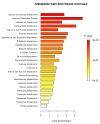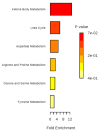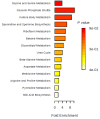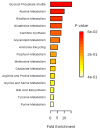Multiplatform Urinary Metabolomics Profiling to Discriminate Cachectic from Non-Cachectic Colorectal Cancer Patients: Pilot Results from the ColoCare Study
- PMID: 31500101
- PMCID: PMC6780796
- DOI: 10.3390/metabo9090178
Multiplatform Urinary Metabolomics Profiling to Discriminate Cachectic from Non-Cachectic Colorectal Cancer Patients: Pilot Results from the ColoCare Study
Abstract
Cachexia is a multifactorial syndrome that is characterized by loss of skeletal muscle mass in cancer patients. The biological pathways involved remain poorly characterized. Here, we compare urinary metabolic profiles in newly diagnosed colorectal cancer patients (stage I-IV) from the ColoCare Study in Heidelberg, Germany. Patients were classified as cachectic (n = 16), pre-cachectic (n = 13), or non-cachectic (n = 23) based on standard criteria on weight loss over time at two time points. Urine samples were collected pre-surgery, and 6 and 12 months thereafter. Fat and muscle mass area were assessed utilizing computed tomography scans at the time of surgery. N = 152 compounds were detected using untargeted metabolomics with gas chromatography-mass spectrometry and n = 154 features with proton nuclear magnetic resonance spectroscopy. Thirty-four metabolites were overlapping across platforms. We calculated differences across groups and performed discriminant and overrepresentation enrichment analysis. We observed a trend for 32 compounds that were nominally significantly different across groups, although not statistically significant after adjustment for multiple testing. Nineteen compounds could be identified, including acetone, hydroquinone, and glycine. Comparing cachectic to non-cachectic patients, higher levels of metabolites such as acetone (Fold change (FC) = 3.17; p = 0.02) and arginine (FC = 0.33; p = 0.04) were observed. The two top pathways identified were glycerol phosphate shuttle metabolism and glycine and serine metabolism pathways. Larger subsequent studies are needed to replicate and validate these results.
Keywords: cancer cachexia; colorectal cancer; metabolomics; serial samples; urinary profiles.
Conflict of interest statement
The authors declare no conflict of interest.
Figures








References
-
- Vagnildhaug O.M., Balstad T.R., Almberg S.S., Brunelli C., Knudsen A.K., Kaasa S., Thronæs M., Laird B., Solheim T.S. A cross-sectional study examining the prevalence of cachexia and areas of unmet need in patients with cancer. Support. Care Cancer. 2018;26:1871–1880. doi: 10.1007/s00520-017-4022-z. - DOI - PubMed
Grants and funding
LinkOut - more resources
Full Text Sources
Medical

